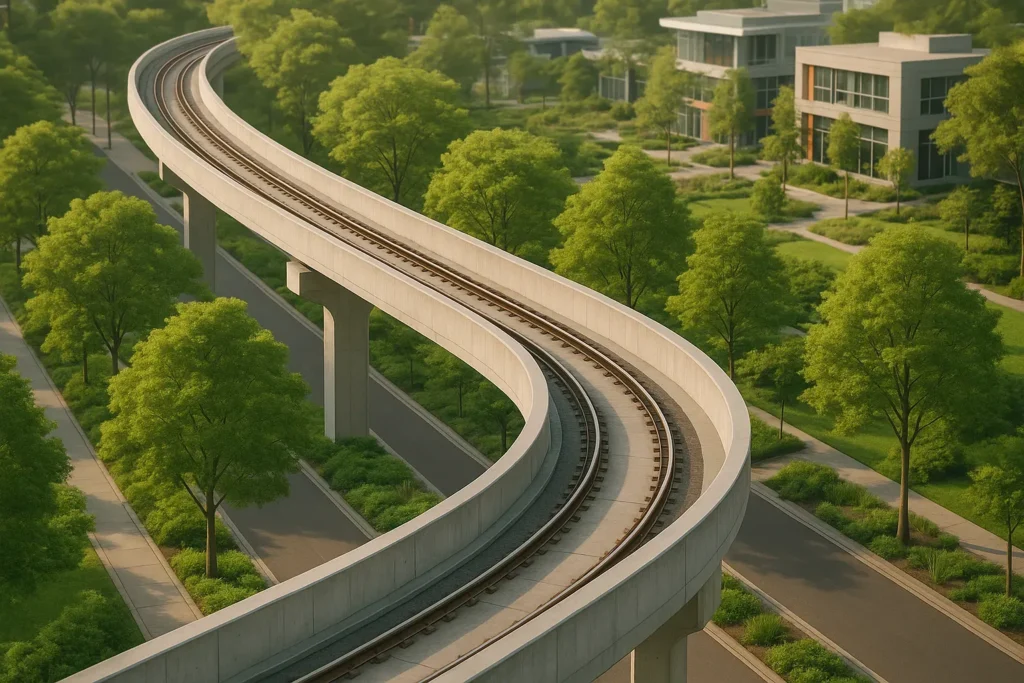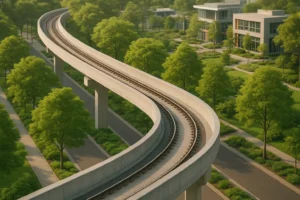Urban transit systems have the power to reshape cities when designed with integration in mind. This article explores three key strategies—dedicated freight corridors, community-oriented transit spaces, and strategic lighting—supported by real-world case studies and expert insights. Learn how these approaches can transform transportation infrastructure into catalysts for better-connected, safer urban environments.
- Apply Strategic Lighting for Safety and Integration
- Create Dedicated Freight Corridors and Logistics Hubs
- Transform Transit Into Connected Community Public Spaces
- Match Station Locations to Population Density Patterns
- Develop Mixed-Use Neighborhoods Around Transit Stations
- Design Adaptable Infrastructure for Future Transit Needs
- Incorporate Public Art to Beautify Transit Areas
- Build Seamless Connections at Multimodal Transit Hubs
Apply Strategic Lighting for Safety and Integration
I run a lighting company that works on major infrastructure projects across Australia, so I see how the right lighting design either makes or breaks urban integration. Most people don’t think about lighting when they picture transit, but it’s what determines whether a space feels safe and welcoming or sketchy and disconnected.
The Sydney Metro project we supplied for is a perfect example of getting it right. They didn’t just throw standard poles around the stations–they used lighting that aligned with CPTED principles (Crime Prevention Through Environmental Design), which creates natural surveillance and eliminates dark corners where people feel unsafe. When you combine proper lighting with green spaces and pedestrian pathways, suddenly that train station becomes somewhere you’d actually want to walk through at night.
Here’s the practical bit most cities miss: transit infrastructure needs to serve multiple purposes from day one. At the Western Sydney International Airport project, we’re supplying custom folding poles that work for both airside operations and public zones–flexibility built in. The same thinking should apply to transit stops: integrate solar lighting that reduces grid dependency, add covered areas that double as community gathering spots, and use materials like aluminium that last decades without becoming eyesores.
The real test is simple–if locals start using the transit area as an actual destination rather than just a pass-through, you’ve integrated it properly. We see this in our sports lighting projects too: upgrade a basketball court with proper LED lighting and suddenly it becomes the neighborhood hangout spot at night, not just a court.

Create Dedicated Freight Corridors and Logistics Hubs
From our perspective in the trucking industry, the key is to create transit systems that work for everyone, from truck drivers and local businesses to the communities they serve. At Truck Driver Institute, we’ve been training drivers since 1973 and have seen firsthand how well-planned infrastructure can help keep goods moving efficiently while maintaining safety in urban environments.
An important element to keep in mind is creating urban freight corridors with dedicated truck routes, properly sized loading zones, and strategic delivery hubs on the outskirts of cities. This can limit traffic congestion downtown while ensuring deliveries arrive on time. Logistics centers or freight villages are great examples of this, bringing together various modes of transportation and logistics into one centralized location to streamline transit, logistics, and distribution. There are plenty in Europe, as well as a few in the U.S., like the logistics hub in Alliance, Texas, where rail and air cargo converge, facilitating more efficient transportation and logistics.

Transform Transit Into Connected Community Public Spaces
Transit systems can be designed to enhance the urban environment by being more than just transportation infrastructure—they can serve as public spaces that connect communities, support local economies, and promote sustainable urban growth. The key lies in thoughtful integration: designing transit that aligns with pedestrian pathways, green spaces, housing, and commercial areas. When stations are walkable, surrounded by mixed-use development, and aesthetically tied to the city’s architecture, they naturally become extensions of the community rather than isolated nodes of movement. Incorporating public art, natural light, and accessible design further ensures that transit spaces feel safe, inviting, and inclusive.
A powerful example of this is Vancouver’s SkyTrain system, particularly along the Canada Line. It’s not just a rapid transit corridor—it’s a spine that helped shape transit-oriented communities. Stations like Marine Drive and Brentwood Town Centre spurred compact, walkable developments featuring housing, shops, and public plazas. The integration of bike paths and pedestrian-friendly design encourages residents to rely less on cars, while the stations themselves reflect local design elements that blend with the surrounding neighborhoods. This project shows how transit, when planned with people in mind, can drive urban renewal, reduce environmental impact, and enhance the overall livability of a city. Rather than simply moving people from point A to B, it creates an environment where the journey itself enriches the urban experience.

Match Station Locations to Population Density Patterns
Placing transit stations in areas where people already live and work makes public transportation more useful for daily life. When planners study population density maps before building new lines, they can ensure stations serve the greatest number of residents. Cities that have matched their transit networks to neighborhood patterns see higher ridership and less empty trains running through sparse areas.
This approach also helps avoid the costly mistake of building expensive infrastructure where few people will use it. Support transit projects in your area that prioritize service to densely populated neighborhoods first.
Develop Mixed-Use Neighborhoods Around Transit Stations
Building homes, shops, and offices near transit stations creates walkable neighborhoods where people can live without depending on cars. This development pattern, known as transit-oriented development, reduces traffic congestion and makes public transportation financially sustainable. When new construction happens within walking distance of stations, more riders use the system throughout the day.
Mixed-use buildings near transit also provide jobs, housing, and services in compact areas that preserve green space elsewhere. Push for zoning changes in your city that allow denser development around existing and planned transit stops.
Design Adaptable Infrastructure for Future Transit Needs
Transit systems built with flexibility in mind can adjust to changing population patterns and new technology over decades. Infrastructure that allows for increased capacity, route modifications, and integration with future transportation innovations serves communities longer. Cities that plan for adaptability avoid expensive rebuilds when needs change, such as when remote work shifts commuting patterns or new neighborhoods emerge.
Flexible design includes features like extra platform space, modular station components, and corridors that can accommodate different vehicle types. Demand that transit planners in your region account for long-term growth and technological change in their designs.
Incorporate Public Art to Beautify Transit Areas
Adding art to subway stations, bus stops, and transit centers transforms these spaces from purely functional areas into welcoming community landmarks. Beautiful murals, sculptures, and creative architecture make waiting for transportation a more pleasant experience. Cities like Stockholm and Mexico City have turned their metro systems into underground galleries that residents feel proud to show visitors.
Art in transit spaces also helps create a sense of place and makes different stations memorable and easier to navigate. Encourage your local transit authority to invest in public art programs that brighten daily commutes for everyone.
Build Seamless Connections at Multimodal Transit Hubs
Successful transit systems create seamless connections between different types of transportation at major hubs. When buses, trains, bike paths, and pedestrian walkways meet at a single point, people can move through the city more easily. Cities like Copenhagen have shown that well-designed hubs reduce travel time and encourage more people to use public transit.
These connections work best when transfer points are covered, well-lit, and include clear signage. Creating better multimodal hubs in your community starts with advocating for connected infrastructure at local planning meetings.







